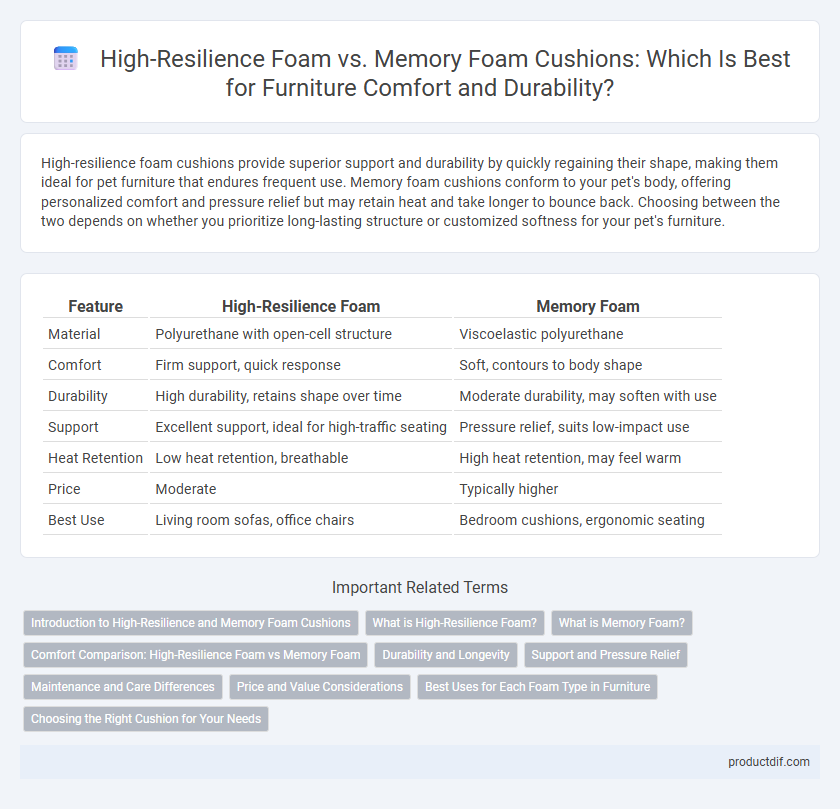High-resilience foam cushions provide superior support and durability by quickly regaining their shape, making them ideal for pet furniture that endures frequent use. Memory foam cushions conform to your pet's body, offering personalized comfort and pressure relief but may retain heat and take longer to bounce back. Choosing between the two depends on whether you prioritize long-lasting structure or customized softness for your pet's furniture.
Table of Comparison
| Feature | High-Resilience Foam | Memory Foam |
|---|---|---|
| Material | Polyurethane with open-cell structure | Viscoelastic polyurethane |
| Comfort | Firm support, quick response | Soft, contours to body shape |
| Durability | High durability, retains shape over time | Moderate durability, may soften with use |
| Support | Excellent support, ideal for high-traffic seating | Pressure relief, suits low-impact use |
| Heat Retention | Low heat retention, breathable | High heat retention, may feel warm |
| Price | Moderate | Typically higher |
| Best Use | Living room sofas, office chairs | Bedroom cushions, ergonomic seating |
Introduction to High-Resilience and Memory Foam Cushions
High-resilience foam cushions offer superior bounce and durability with a dense, elastic structure that maintains shape under frequent use, making them ideal for long-lasting furniture comfort. Memory foam cushions conform closely to body contours by responding to heat and pressure, providing personalized support and reducing pressure points. Both foam types enhance seating comfort but differ in resilience and adaptive qualities depending on user preference and furniture function.
What is High-Resilience Foam?
High-resilience foam is a durable, supportive cushion material made from high-quality polyurethane, designed to provide excellent bounce and long-lasting comfort. Its open-cell structure allows better air circulation, making it more breathable than memory foam. This foam type is commonly used in high-end furniture for enhanced support and resilience, ideal for maintaining shape over extended use.
What is Memory Foam?
Memory foam is a viscoelastic polyurethane material designed to conform to body contours, providing pressure relief and personalized comfort in furniture cushions. It reacts to body heat and weight, allowing for even weight distribution and reducing pressure points. This foam is commonly used in high-quality sofas and mattresses for enhanced support and durability.
Comfort Comparison: High-Resilience Foam vs Memory Foam
High-resilience foam cushions offer superior support and durability, maintaining their shape longer while providing a bouncy and responsive seating experience. Memory foam cushions excel in contouring to the body's shape, delivering personalized pressure relief and enhanced comfort by evenly distributing weight. Choosing between high-resilience and memory foam cushions depends on preferences for firmer support versus adaptive softness in furniture comfort.
Durability and Longevity
High-resilience foam cushions offer superior durability due to their dense, flexible cell structure that maintains shape and support over extended use. Memory foam cushions provide excellent comfort by contouring to the body but tend to degrade faster, with reduced resilience after prolonged pressure. For long-lasting furniture, high-resilience foam is the optimal choice, balancing comfort with extended lifespan and consistent performance.
Support and Pressure Relief
High-resilience foam cushions offer superior support due to their durable, responsive structure that maintains shape over time, making them ideal for long-term seating comfort. Memory foam cushions excel in pressure relief by contouring to the body's shape, distributing weight evenly to reduce stress on pressure points. Choosing between high-resilience and memory foam depends on whether support longevity or personalized pressure relief is the priority in furniture seating.
Maintenance and Care Differences
High-resilience foam cushions require minimal maintenance, often needing only regular fluffing and occasional vacuuming to remove dust, while memory foam cushions benefit from gentle spot cleaning and airing out to prevent odor buildup. Memory foam's closed-cell structure resists allergens but can retain moisture if not properly dried, making careful drying essential to avoid mold growth. High-resilience foam's durability allows it to maintain shape longer under frequent compression, reducing the need for frequent replacement or intensive upkeep.
Price and Value Considerations
High-resilience foam cushions typically cost less than memory foam, offering superior durability and support for extended use, making them a cost-effective choice for budget-conscious buyers. Memory foam cushions provide excellent pressure relief and contouring but generally come at a higher price point, reflecting their advanced material technology. Consumers seeking long-term value prioritize high-resilience foam for longevity, while those valuing comfort and contouring often invest in memory foam despite the premium cost.
Best Uses for Each Foam Type in Furniture
High-resilience foam cushions offer superior durability and support, making them ideal for frequently used furniture such as sofas and chairs in living rooms or commercial settings where bounce-back and shape retention are crucial. Memory foam cushions excel in ergonomic comfort and pressure relief, making them the preferred choice for home recliners, mattresses, and seating designed for relaxation and extended use. Choosing the right foam depends on the balance between firmness needed for structural support and contouring comfort desired for personalized seating experiences.
Choosing the Right Cushion for Your Needs
High-resilience foam cushions offer superior durability and support with their fast recovery rate, making them ideal for long-term use and active seating areas. Memory foam cushions conform closely to body contours, providing excellent pressure relief and comfort, which is beneficial for individuals seeking targeted support and reduced joint strain. Selecting the right cushion depends on factors such as intended usage, desired firmness, and the need for durability versus personalized comfort.
High-resilience Foam vs Memory Foam Cushions Infographic

 productdif.com
productdif.com